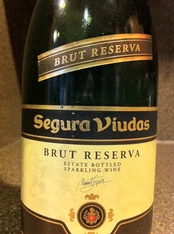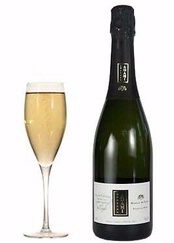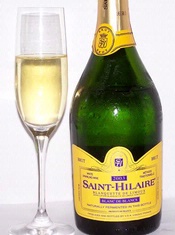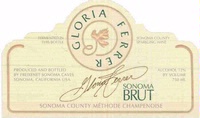In a perfect world, we would spend our summer afternoons refreshing and reviving the palate with a glass or two of fine Champagne. The only problem with that picture is the bar tab. For many, Champagne is a luxury not to be indulged on a daily basis because the cost would be prohibitive.
There are numerous alternatives that are nearly as satisfying at a fraction of the cost. The following are but a few suggestions that may well help you stay cool through the dog days of summer without draining your wine budget.
 Cava: This is the top tier of sparkling wine from Spain and must be made using the “Champagne” method, with a second fermentation in the bottle, to be labeled Cava. Most Cava is produced in the Catalonia region of northeastern Spain from a variety of grapes, including macabeu, parellada and xarel-lo. The Spanish Cava producer Freixenet is in fact the largest sparkling-wine producer in the world. Cava tends to be lighter and less complex than Champagne, though there are exceptions. Most Cava retails for less than $20 a bottle, and much of it hovers in the $10 range. A well-made Cava will be crisp and refreshing.
Cava: This is the top tier of sparkling wine from Spain and must be made using the “Champagne” method, with a second fermentation in the bottle, to be labeled Cava. Most Cava is produced in the Catalonia region of northeastern Spain from a variety of grapes, including macabeu, parellada and xarel-lo. The Spanish Cava producer Freixenet is in fact the largest sparkling-wine producer in the world. Cava tends to be lighter and less complex than Champagne, though there are exceptions. Most Cava retails for less than $20 a bottle, and much of it hovers in the $10 range. A well-made Cava will be crisp and refreshing.
 Prosecco: This Italian bubbly has enjoyed a renaissance of late and is growing in popularity in the United States due to both improved quality and tremendous value. Prosecco DOC is made in the Veneto and Friuli Venezia Giulia regions of northeastern Italy. The finest Prosecco is produced around the areas of Valdobbiadene and Conegliano. Style varies from brut to extra dry, extra dry being slightly sweeter. My two favorite producers are Bisol and Adami, which reside at the most expensive end of the Prosecco hierarchy. But Bolla and Ruffino both make delicious Prosecco that retails for less than $15.
Prosecco: This Italian bubbly has enjoyed a renaissance of late and is growing in popularity in the United States due to both improved quality and tremendous value. Prosecco DOC is made in the Veneto and Friuli Venezia Giulia regions of northeastern Italy. The finest Prosecco is produced around the areas of Valdobbiadene and Conegliano. Style varies from brut to extra dry, extra dry being slightly sweeter. My two favorite producers are Bisol and Adami, which reside at the most expensive end of the Prosecco hierarchy. But Bolla and Ruffino both make delicious Prosecco that retails for less than $15.
 Blanquette de Limoux: There is considerable evidence that Limoux, in the Languedoc region in the south of France, was the birthplace of sparkling wine. Legend has it that Dom Perignon stopped to rest in at the Abbey Saint-Hilaire, near Limoux, as he made his pilgrimage to Santiago de Compestela. It was there that he found the monks making sparkling wine from the local mauzac grape. A second wine from the region, Cremant de Limoux, is made from chenin blanc and chardonnay grapes. The delicious Saint-Hilaire Blanquet retails for about $14.
Blanquette de Limoux: There is considerable evidence that Limoux, in the Languedoc region in the south of France, was the birthplace of sparkling wine. Legend has it that Dom Perignon stopped to rest in at the Abbey Saint-Hilaire, near Limoux, as he made his pilgrimage to Santiago de Compestela. It was there that he found the monks making sparkling wine from the local mauzac grape. A second wine from the region, Cremant de Limoux, is made from chenin blanc and chardonnay grapes. The delicious Saint-Hilaire Blanquet retails for about $14.
 Domestic bubbly: Sparkling wine in the United States has improved dramatically as a category over the past decade, with quality bubbly now being made in upstate New York (Chateau Frank) and Long Island (Sparkling Pointe). While both are quite good, neither is cheap. So for value I would look to California, where the vast majority of domestic sparkling wine is produced. The top producers, of course, make wines that rival Champagne in price, but also do a very good job at the entry level. Two that are reliably good and fairly priced are Mumm Napa Valley Brut Prestige ($18 average price at Wine-Searcher.com) and Gloria Ferrer Brut ($17 average price). And if those prices are even a bit too steep for everyday sipping, the Korbel Brut Rose ($10 average price) is one of the best at that price point.
Domestic bubbly: Sparkling wine in the United States has improved dramatically as a category over the past decade, with quality bubbly now being made in upstate New York (Chateau Frank) and Long Island (Sparkling Pointe). While both are quite good, neither is cheap. So for value I would look to California, where the vast majority of domestic sparkling wine is produced. The top producers, of course, make wines that rival Champagne in price, but also do a very good job at the entry level. Two that are reliably good and fairly priced are Mumm Napa Valley Brut Prestige ($18 average price at Wine-Searcher.com) and Gloria Ferrer Brut ($17 average price). And if those prices are even a bit too steep for everyday sipping, the Korbel Brut Rose ($10 average price) is one of the best at that price point.
8
